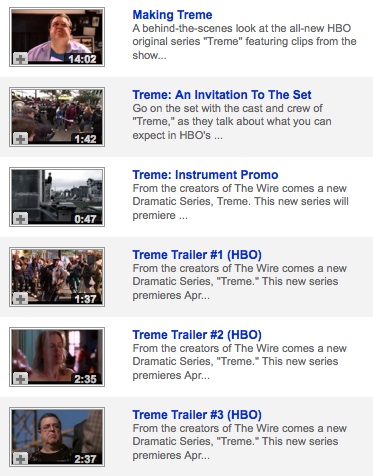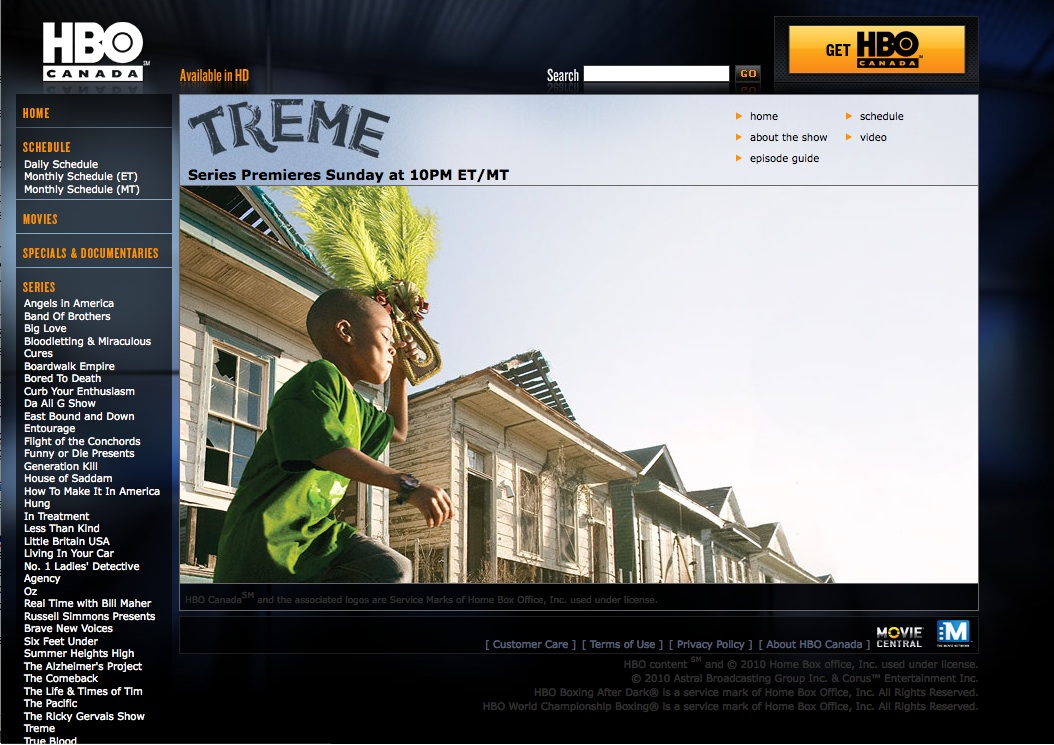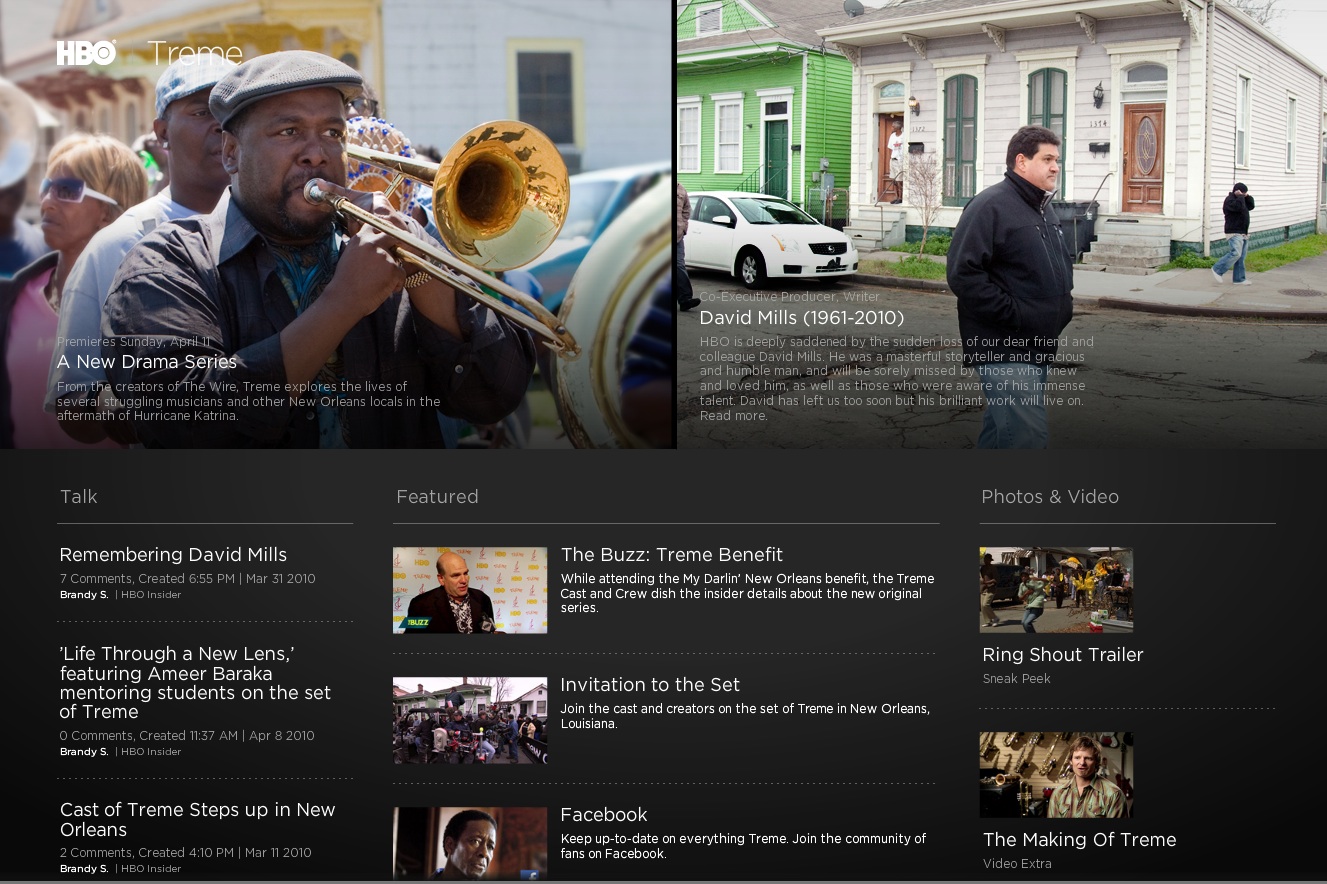I’m a huge The Wire fan, in fact my first post to this blog — which remains one of the most popular — is a breakdown the pilot of the The Wire. I think Simon is one of the masters working in the TV industry now and I particularly admire his work because he bends the television form to his will. The Wire has way more in common with the narrative stylings of a novel than with typically episodic storytelling of television.
So I have been extremely excited about Treme and have spent a lot of time online looking for news and information obout the series — especially stuff I can embed or report on in the blog. There has been little. In the last couple of weeks there has been a flood of interviews with Simon in magazines and on TV, but the web has been seriously under used.
Yesterday, in the hours leading up to the premiere, I did a quick survey of how the series is using the web. Many of the right components are in place, they’re just not being used to advantage.
There’s a YouTube channel, with just 25 subscribers and six videos. You can’t even see who the subscribers are and there’s no wall for discussion. There are a few comments under the videos, but no moderator, so no one answers questions or stimulates the discussion.
There’s a Facebook fan page with 8,000 fans before the pilot aired and 9,200 as of this morning. There’s lots of fan commenting but almost nothing in the way of official content about the series. There are 2 videos, 2 images of the series and 2 half hearted attempts by the admin to start discussions. On the other hand, there’s quite a lot of user generated content but none of it supported or aknowledged by the hosts of the page. About half the links which are mostly to magazine articles are supplied by the admin and the rest by fans with no thanks, comments or encouragment by the admin. There are three user started discussions, again no participation by the admin. And there are 30 user photos, including an actor-submitted headshot and some advertizing for a documentary on Treme, which at the very least deserve some comment from the admins if they are going to remove it.
There’s no Treme twitter account, but there were five tweets about the show over the last five days from HBO’s official twitter feed and the hash tag #treme is very well-used.
What about Treme.com? It’s just a holding page that doesn’t seem to belong to the series. The only web sites are on the HBO sites, as usual Canada’s version of the page is a lot thinner than the US page, offering only a splash page with a single image of the series, a one paragraph “about the show”, an episode guide (synopses of the episodes that have aired), a schedule and a page of videos which — to Canada’s credit — actually has more videos than the US page — but alas, not embeddable.
The HBO US site looks busier and certainly has a little more effort put into it, but it’s still a big fail. You can watch a mere 7 videos, six of which are on YouTube. There are six photos in the slideshow, none of which I can embed on my blog or use for my profile picture this week on Twitter. There is a forum for user discussion which is great, but there are only five topics seeded by “HBO insiders” with little discussion on them. And when there is discussion the HBO Insiders who should be doing the community management, haven’t added any new comments or responded to questions. Thee’s a link to an offsire benefit for the musicians of New Orleans, a link to a Twitter search for the hashtag Treme, but not that much else.
Even the usual boring stuff that every series manages to put on the web is missing: no cast bios, no character descriptions, nothing about the crew or David Simon.
What a wasted opportunity. You can see from the Twitter buzz, the fan comments on the Fasebook fan page and the number of blog posts written about Treme that the online world is hungry to talk about the show. So why is the series putting so little effort into helping them do it, by providing spaces, encouraging discussion and giving them assets like photos, video and music to dress up their blog posts, Twitter streams and Facebook pages?
I think part of the problem is that David Simon blames the web for the demise of the newspaper industry. Yeah, it’s true that the newspaper business has suffered with the growth of the online world. But it’s pretty silly to ignore the potential of the medium because another medium has suffered. And in many ways, the web is extremely well suited to David Simon and vice versa.
Look at the letter Simon sent to the people of New Orleans on the eve of the premiere of Treme, not found by the way on any of the official Treme sites even if it is linked to. Simon speaks profoundly and directly to the people of New Orleans. That something that the web does incredibly effectively — allows creators to build an intimate, one-to-one relationship with the audience. A little more of this kind of thing from Treme would go a long way to promoting the series, building audience and setting up an enormous loyalty to the brand.
But there are a ton of simple things that Treme could do cheaply and effectively. First, they need to get their community managers — the “HBO Insiders” and the Facebook admins — to be more active. They should be responding to user comments and contributions, joining and encouraging conversation and at the very least responding to the many questions on Facebook and the HBO site about how and when to watch the show. Secondly, they need to supply the web with more sharable video and lots and lots more images that can be used in blog posts and as profile pictures and so on.




Robbo
What they really need to do is hire you as their transmedia producer.
admin
Wouldn’t that be nice? A dream come true really.